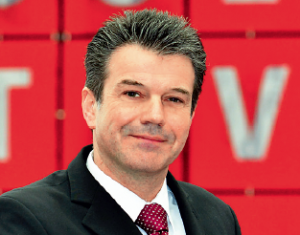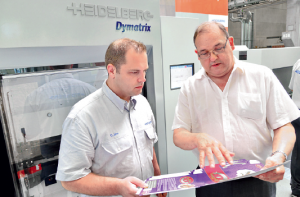Offering a comprehensive portfolio of kit and software, Heidelberger Druckmaschinen AG (Heidelberg) is reaching for a bigger slice of the packaging market, Kilian Renschler tells Packaging MEA.

This autumn, Heidelberg’s Print Media Centre (PMC) welcomed 300 visitors to show, in the words of a demonstrator, how the firm has “walked its talk” at Drupa in post-press.
At the PMC’s largest event so far, print professionals were introduced to new technology that clears folding bottlenecks, checks the thickness of glue application and removes die-cutting blanks without stripping tools.
In addition, Heidelberg’s guests were shown how to integrate new kit and their entire workflows through the firm’s Prinect software.
From pre-press to finishing
But for Kilian Renschler, vice-president for global accounts in packaging, the event also demonstrated an aspect of Heidelberg he sees as “unique”.
“We are the only supplier who can show customers the entire workflow,” he told Packaging MEA.
“In the Middle East, for instance, there was a greenfield installation where we not only completed the layout of the factory and all equipment along the production chain but took responsibility for training staff. Their operators came here to Heidelberg for training.”
For customers, the benefits can include a service contract covering the entire installation, he said.
“But, of course, we must compete on every equipment purchase rather than just on the total production chain,” said Renschler.
Heidelberg showcases its packaging technology at the Print Media Centre that has occupied a 4,000sqm space at hall 11 at the company’s Wiesloch-Walldorf site since 2008.
“Our goal was to create an ideal setup that is as close as possible to the manufacturing environment of our customers,” said Renschler.
“We aim to show our customers the full solution from prepress to die-cutting and gluers in different formats and with different applications. So it can be a simple five- or six-colour job with coating. It can also be an eight-colour job with cold foil application or pre-coating.”
The PMC holds about 500 demonstrations each year, as well as three or four annual open houses, with a permanent display of six presses, three die-cutters and four folder-gluers.
“Customers really appreciate having a first-hand experience and technical exchange,” said Renschler.
Growing the portfolio
Kit installed at the PMC reflects a range of price points as well as technologies.

Top-end lines, for example, feature fully automatic pile changers to help feed highspeed lines or presses in which offset is combined with multiple flexo units, dryers and cold foilers.
But Heidelberg is also aiming to meet demand in markets where automation takes a lower priority.
“In the dominant format 70×100 for packaging, with the Speedmaster CD 102, CX 102 and XL 106, we have three platforms we can offer customers according to their requirements,” said Renschler.
“Then we have the capability to equip these three platforms with a differing degree of automation… For example, in countries where labour costs are still low, customers won’t invest in automatic washup devices.”
A similar range in offer between value, professional and peak-performance is found in finishing kit, he added.
“We have the Varimatrix, which is entry-level die-cutting, as well as the Easygluer,” he said.
“But as emerging markets develop, their labour costs and demand for more output will increase and packagers in these regions will start to look for more automated equipment such as Dymatrix die-cutters or Diana X folder gluers.”
New price points
Heidelberg has also looked outside Europe to supply standard kit for emerging markets. A factory near Shanghai in China,now the firm’s top market, has supplied presses and folders for the local market since 2006.
“These machines comply with the health and safety standards of Europe and these are very solid good machines,” he said.
“They don’t perform at the same level as the ones we manufacture here in Germany in terms of output per hour, sheets on the floor, but these machines serve customer demands well and do their job well.”
In his view, though, Heidelberg’s spare parts supply and service organisation also deliver crucial advantages over Asian kit.
“I think this is where Heidelberg can create value for customers even when the product is an OEM product,” he said.
Meanwhile, at the top end of its portfolio, Heidelberg is taking on market-leading Bobst with its high-performance finishing gear.
“The Dymatrix 106 CSB cutting station runs at 9,000 sheets per hour and has unique features like the moving upper platen, which eliminates vertical movement of the sheet and therefore gives customers the option to reduce nicks and on some jobs even eliminating them,” said Renschler.
An even faster solution is provided by an adjusted Speedmaster XL106 with rotary die-cutters that each hour can fly through 12,500 sheets of substrates as thin as 50 microns.
“In some areas we are already market leaders in finishing,” said Renschler.
“If you look at Germany for example, we sold more machines than Bobst, comparing the classes where we compete with them.”
Traditional skills
In its commitment to packaging, Heidelberg is both playing to its manufacturing strengths and targeting a market with a significant potential.
In the firm’s analysis, sheetfed offset makes the most commercial sense in packaging lines, in the absence of “a high volume of special products”, said Renschler.
Through collaborations with Gallus as well as Ricoh and Fujifilm, Heidelberg is also covering opportunities in webfed and the rising digital market, also for packaging.
While traditional markets in commercial print have withered in the global downturn, Heidelberg sees its expertise as just as precious for the rising sector of packaging.
The hallmarks of the firm’s approach include making a high proportion of its components and recruiting through long apprenticeships.
Across its sites in Germany, Heidelberg has about 500 apprentices who follow a course lasting three and a half years.
“It’s a substantial investment but we see it as part of Heidelberg’s unique model,” said Renschler.
Packaging’s potential
Heidelberg’s analysis of packaging spotlights the glaring discrepancy between the current size of regional markets and their populations.
Japan, for instance, made up a tenth of the global packaging market in 2011 despite having only 2% of the world’s inhabitants.

Similarly, North America held 23% of the global market with just 5% of the global population. Europe took a 36% slice of the market, estimated at €461bn, with only 13% of global consumers.
Over the next few years, Heidelberg expects these imbalances to ease as emerging regions close the gap on established markets.
In the Middle East and Africa, the firm expects the market to expand at an average of 3% to 2015, while packaging ebbs in Western Europe and edges up in North America by only 1.3% a year.
Strategy in the MEA
Heidelberg’s response to the post-2008 context has four key elements, including a focus on emerging markets such as the Middle East and Africa.
Alongside this shift, the firm aims to concentrate more on packaging and on services and consumables.
“With printing presses running 18,000 sheets per hour, you need to have consumables that work,” said Renschler.
The fourth objective is to develop in digital and other new businesses.
“Digital printing already has a big share in label printing,” he said.
“Of course, HP with a liquid toner is the market leader right now. But we believe with the upcoming inkjet technology, where we work closely with Fujifilm, you can achieve a higher quality – and I think this is why inkjet will have a stronger inroad into digital label printing.”
Through its partnership with Gallus, in which it holds a 30% share, Heidelberg has recently participated in a major packaging installation in the Gulf.
A Gallus ICS 670 was installed at Emirates Printing Press in Dubai in an inline configuration for folding cartons featuring four gravure units, nine EVA (easy added value) platforms, a rotary embossing unit and a Gallus FCL 670 flatbed die-cutter.
Finishing options such as cold foiling, lamination, hot foil embossing and rotary hot foil embossing can be integrated into the platform.
Prinect workflow
For such complex packaging installations, Heidelberg offers integration through its Prinect workflow, designed to integrate all processes in management and production at a print shop.
At the firm’s recent post-press event, Christian Elsner described the package as a key tool to increase transparency, highlighting the efficiency of operators as well as machinery.
Designed to suit the variety of kit, including manual processes, found in many packaging setups, Prinect is “a very open system”, he added.
“Customers can convert their traditional way of working into a transparent digital way,” he said.
The package offers the same tools across prepress, press and post-press, automatically re-using data to improve productivity. Job reports for finished operations enable further analysis that can help optimise makeready and cut waste.
Looking for growth
A growing packaging portfolio is now central to maintaining the traditions that won Heidelberg its dominance in print.
But in packaging, especially in younger markets as the Middle East and Africa, Heidelberg is not just an established player but a contender hungry for growth, said Renschler.
“We still have the possibility to improve our market share,” he said.
Heidelberg’s forecasts for the packaging market:
Heidelberg’s expanding packaging portfolio reflects a strategy based on how four key trends are transforming the sector.
“With the crisis in 2008, the market has clearly changed, accelerated,” said Kilian Renschler, vice president for global accounts.
Among brand owners, the downturn has prompted a drive to streamline the supply chain and optimise inventories.
“The big brand owners don’t want contracts for millions of boxes,” he said.
“They will order only enough to supply retailers, which leads to short runs for our customers and expectations to deliver fast once the order is placed.”
Heidelberg is meeting this development by offering versatile machines that can change job fast and are not geared to a single contract, he added.
“With shorter runs, we need to have machines optimised in makeready and waste,” he said.
The firm’s response to this shift includes intelligent colour control systems like Prinect Inpress Contro or Prinect Image Control that can cut makeready times.
Meanwhile, rising competition among brand owners and in retail is raising pressure on margins for packagers, he added.
The result is an increase both in specialisation and in cross-segment selling.
“We see a growth in customised and specialised equipment, which can be printing configurations with cold foil, with perfecting devices, or multiple coating configurations, but also on the folder-gluer side we see more complex configurations,” he said.
With cross-segment selling, such as a pharmaceutical printer embarking in cosmetics, he also sees potential threats for established players.
“What we have seen is that some given price structures can be vulnerable,” he said.
But the marketplace’s new challenges are accompanied by opportunities, he added.
“Brands are becoming more global,” he said. “Ten years ago, a German customer might go to Poland or France. Now, a German operator might go to Chile or Mexico or Korea.”
In addition, the global packaging market is seeing a series of consolidations and alliances, which can also result in new demands on packagers for quality or productivity.
“Whenever a customer has to serve a brand globally, they are looking for partners who can deliver in a joint effort,” he said.
“With our global network of sales and services, we can support our customers when they want to set up new facilities. They can rely on our network.”
Colour management and standards are becoming more and more important, in his view.
“Coca-cola red needs to be the same in Europe as it is in Asia,” he said. “So here, with our colour control, we offer our customers a standardised tool to reproduce the same quality on a global scale.”
Sustainability and product safety provides the fourth key trend in Renschler’s analysis.
“Our customers are seeking to minimise waste and energy consumption, certainly for cost reasons but also for sustainability,” he said
Heidelberg’s focus to meet this demand extends from highly efficient peripheral devices to inspection systems and consumables.




0 Replies to “Heidelberg targets packaging workflow”